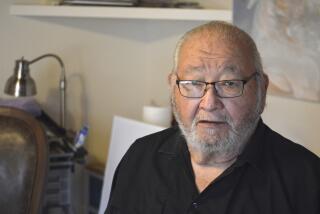Hemingway’s Attic Provides Novelist a Muse
- Share via
OAK PARK, Ill. — Like all writers, William Elliott Hazelgrove yearned for a clean and pleasant place in which to pursue his craft.
Over the years, he drafted three novels in a storage room, a coffee house and various basements around Chicago. After he moved from the city to this western suburb and his newborn child ended any hope of focusing at home, he was consigned to a bakery near the train station.
One dark March afternoon in 1997, walking home from his labors, he noticed a light shining in a turreted, white-framed house with a veranda.
He knew the Victorian was a museum, the place where Ernest Hemingway, and, arguably, modern American fiction, had been born in 1899.
“God, that’d be a great place to write,” he remembers thinking. “I wonder if they have any space.”
Today, he is on exhibit there himself as he toils in Hemingway’s attic. Tourists and schoolchildren--even the occasional Papa look-alike contest winner--stand rapt while docents introduce a casually dressed man with an open countenance topped by curly red hair.
“This,” the guides say cheerfully, “is our writer.”
Such interruptions can be troublesome if Hazelgrove is engrossed in the details of, say, a love scene. Yet the arrangement has compensatory charms for someone who loves literature and aspires to build worlds with words.
Hazelgrove read “A Farewell to Arms” while on a settee in the parlor, facing the level gaze of the author himself, photographed as a very young boy. He sometimes finds himself muttering at the end of a writing session: “Ernest, you wouldn’t f--- [as the word appears in Hemingway’s works] believe the day I’ve had today.”
After more than a year in the house, among Grace Hemingway’s cookbooks and Clarence Hemingway’s bound National Geographics, Hazelgrove has gleaned insights into the forming of Ernest’s character: the ordered propriety that played suffocating foil to adventure tales told by Uncle Leicester, who searched for gold in the Klondike, and Great-Uncle Tyley, who traveled to New Zealand aboard a cargo ship.
The combination “starts to seep into you,” Hazelgrove said. “You think, let’s risk a lot. Go as high as you can, as far as you can in life. Let’s try and create something that could possibly be great.” He also stumbled upon a more specific muse.
He’d been struggling with a novel set in the North Woods, a suitably Hemingwayesque locale. One day, a steamer trunk outside his tiny garret room caught his attention. There, under the rafters, inhaling a near-century’s must, he was inspired to start a new work, putting the other aside.
The trunk, which belonged to Hemingway’s sister, Marcelline, now plays a featured role, as “a repository of dreams,” in Hazelgrove’s novel titled, aptly enough, “Hemingway’s Attic.”
He is polishing it now and says the plot centers on a contemporary writer’s experiences--a departure from his previous books, which are set in the past.
“This book just flew,” he said. “I think I broke through.” At age 39, he said, “I’m finally turning into a man.”
He knows the story of his story sounds a bit contrived and is aware of its publicity value. So is the Ernest Hemingway Foundation of Oak Park, which owns and manages the birthplace.
Still, the foundation didn’t jump at first to grant Hazelgrove’s request. The day he impulsively climbed the steps, he was grilled by the guide at the door.
“What kind of books do you write?” she asked. “Do you write smutty books?” Fittingly, she used the word applied to Hemingway’s direct style by many in his horrified hometown when his stories were first published.
But no, Hazelgrove assured her, his did not fit in that category. Foundation officials read his published work and decided “it seemed to be a natural connection to make,” said executive director Jennifer Wheeler.
Hazelgrove installed an old table, a painting by his mother, a framed review of one of his books and his laptop computer. Before and after tour hours, he ventured downstairs.
For a long while, he felt like an intruder. Even now, he said, “this is Ernest Hemingway’s house, not mine.”
The spell it has cast seems all the MORE powerful given that Hemingway is not even Hazelgrove’s favorite writer; he prefers F. Scott Fitzgerald.
And Hemingway only lived in the Victorian until he was 6.
Yet the boy Ernest did dictate his first known book within these walls. At the age of 2 years, 7 months, he drew a series of squiggles. His mother carefully wrote the text he desired under each. The result was a triumph of pared-down prose and a remarkable foreshadowing of later themes.
“Giraffe,” young Hemingway ordered for one page. And on the next: “Sailing over the sea.” Then, “two guns.” “Noah’s ark with animals in it.” Followed by: “A tree.” “Pipe.” “Bow and arrow.” “Man in moon.”
More to Read
Sign up for our Book Club newsletter
Get the latest news, events and more from the Los Angeles Times Book Club, and help us get L.A. reading and talking.
You may occasionally receive promotional content from the Los Angeles Times.







